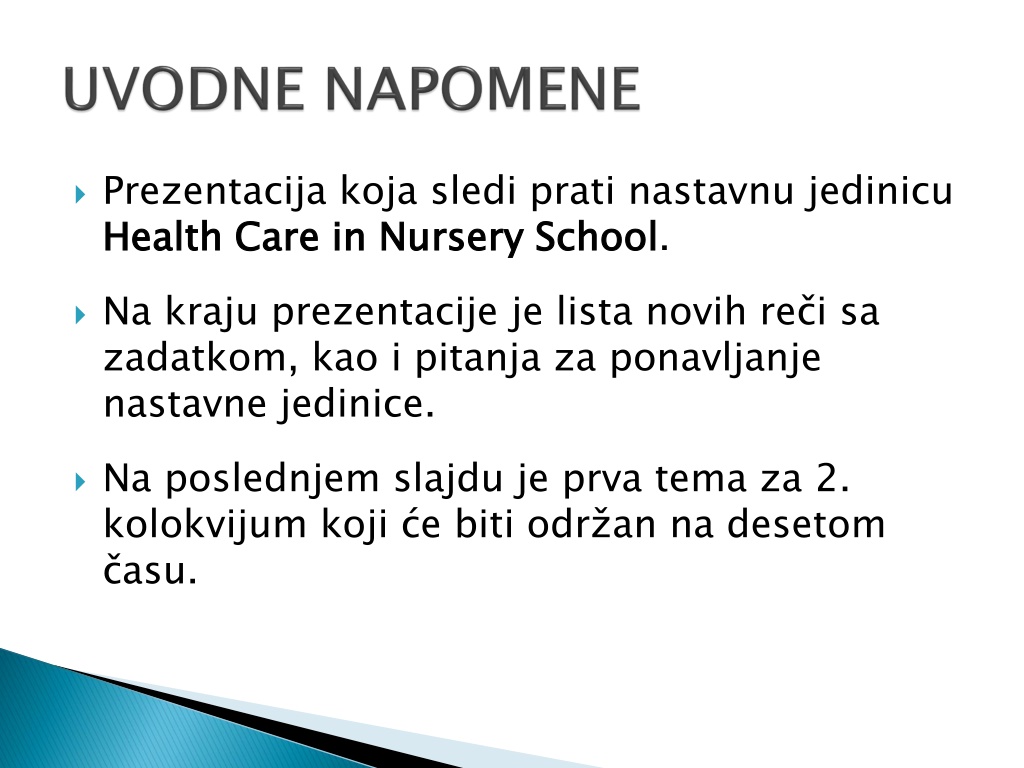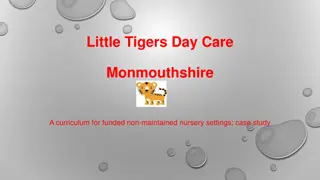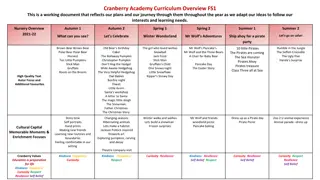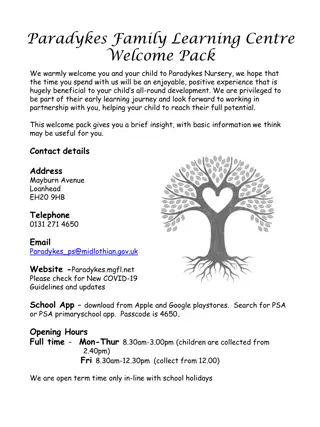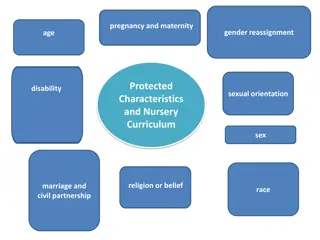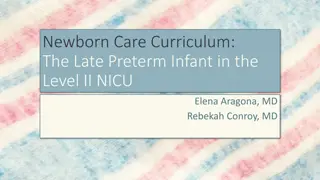Proper Health Care Practices in Nursery Schools
Health care in nursery schools is crucial to prevent the spread of diseases among children and staff. This presentation emphasizes proper handwashing techniques, safe diapering procedures, and other measures like wearing gloves and cleaning surfaces to maintain a healthy environment. Teachers play a key role in implementing these practices to safeguard the well-being of everyone in the nursery school setting.
Download Presentation

Please find below an Image/Link to download the presentation.
The content on the website is provided AS IS for your information and personal use only. It may not be sold, licensed, or shared on other websites without obtaining consent from the author. Download presentation by click this link. If you encounter any issues during the download, it is possible that the publisher has removed the file from their server.
E N D
Presentation Transcript
Prezentacija koja sledi prati nastavnu jedinicu Health Care Health Care in Nursery School in Nursery School. Na kraju prezentacije je lista novih re i sa zadatkom, kao i pitanja za ponavljanje nastavne jedinice. Na poslednjem slajdu je prva tema za 2. kolokvijum koji e biti odr an na desetom asu.
Proper Procedures: Proper Procedures: Preventing the Spread of Disease in Infant and Toddler Classrooms Preventing the Spread of Disease in Infant and Toddler Classrooms
Children and their teachers come in contact with a variety of bodily fluids on a daily basis. Therefore, teachers must be trained to protect the health of the children and their own health.
1) proper handwashing procedures, 2) wearing disposable latex gloves whenever in contact with body fluids
3) cleaning all surfaces with a disinfectant 4) disposing of infectious materials (e.g. contaminated clothing, diapers) in the proper manner, and 5) wearing a face mask, as a new measure to prevent spreading Covid-19
Here, we are going to focus on: HANDWASHING AS A CONTROL MEASURE SAFE DIAPERING PROCEDURES
Following the proper procedures for washing hands is critical to the prevention of disease in early childhood facilities.
There are specific times of the day when teachers should wash their hands: 1) before working with the children at the beginning of the day, 2) before diapering, 3) before preparing and serving bottles or other food,
4) after wiping a nose, 5) after administering first aid, 6) after diapering or helping a child use the toilet, and 7) before leaving the classroom for a break or at the end of the day.
Children's hands should be washed as often as teachers. Posting the procedures with accompanying pictures helps everyone to remember how to wash their hands properly.
Turn the water on. Make sure that it is at a comfortable temperature and that disposable paper towels are available. Moisten your hands under water and apply enough liquid soap.
Wash your hands for 15 to 20 seconds. Scrub the front and back of your hands up to your wrists, between your fingers, and under your nails. Rinse your hands under the running water.
Dry your hands with disposable paper towels. Turn the water off by grasping faucet (tap) handles with the paper towel you used to dry your hands. Dispose of the paper towel in the trash can. Apply hand lotion to prevent cracking of the skin.
Many communicable diseases can be spread through improper diapering. The procedures for diapering should be clearly posted with accompanying pictures.
Get all of the supplies that you need (diaper, wipes, latex gloves, clothes, etc.). Wash your hands, following the recommended procedures, and put on latex gloves.
Place the child on a table and buckle the strap to assist holding him or her in place. Never leave the child unattended.
Put the soiled clothes in a bag and securely tie it to send home. Open the diaper and fold over the tabs so they do not stick to the child's skin. Leave the soiled diaper under the child.
Clean the child with baby wipes from front to back using a fresh wipe each time. Place the wipes inside the dirty diaper. Remove the dirty diaper from underneath the child. Re-secure diaper with tabs.
Remove the latex gloves by holding the diaper in your left hand and using the right hand to pull the left glove off your hand and over the diaper. Repeat with the right hand. (This way the germs stay inside the diaper and gloves.)
Dispose of the diaper in a covered, lined step can or place the diaper on the corner of the changing table out of the child's reach. Wash your hands with a disposable wipe. Dispose of the wipe.
Put the clean diaper on and redress the child. Assist the child in washing his or her hands. If the child is too young, you can wash his/her hands with either a baby wipe or wet, soapy paper towels. Return the child to the play area.
Dispose of all the materials if it wasn't possible to do so before now. Sanitize the changing table. Wash your own hands. Record the diaper change on the child's chart.
Following universal infection control precautions can greatly reduce the chances of children and teachers contracting communicable diseases.
Explain the meaning of the following words in English and give the Serbian equivalent: bodily fluids communicable diseases dispose of sth disposable latex spread diaper Explain the meaning of the following words in English and give the Serbian equivalent:
moisten scrub rinse faucet (UK: tap) unattended soiled tab baby wipes germs lined step can sanitize precautions
Allergies Acute Otitis Media (AOM) Asthma Bronchitis Chicken Pox Colds (Rhinovirus) Conjunctivitis (bacterial/viral) Gastroenteritis Hand, Foot and Mouth Disease Hepatitis A Hepatitis B
Influenza (Flu) Lice Measles Meningitis (bacterial/viral) Mumps Otitis media (ear infections) Pharyngitis (sore throat) Pinworms; ringworm; tapeworm Pneumonia Salmonella Streptococcus pneumoniae ( strep ) Tonsillitis Whooping cough COVID-19
Answer the questions What are communicable diseases? Give a few examples of the most common ones. What are the most important precaution measures? What are the other ways of health care in nursery school (besides handwashing and safe diapering)? Answer the questions: :
How can you prevent spreading diseases in nursery school?
